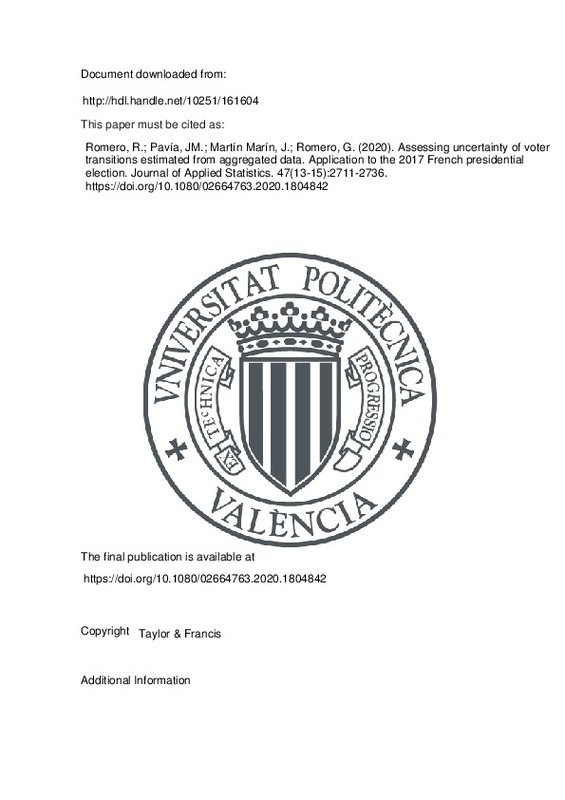U. Baydoğan, Vote transitions analysis and comparison of Turkish local elections in 2014 and 2019, Ph.D. diss., Mef University, 2019.
M. Berkelaar and others, lpSolve: Interface to Lp_solve v. 5.5 to Solve Linear/Integer Programs. R package version 5.6.10, 2014. Available at https://CRAN.R-project.org/package=lpSolve
Brown, P. J., & Payne, C. D. (1986). Aggregate Data, Ecological Regression, and Voting Transitions. Journal of the American Statistical Association, 81(394), 452-460. doi:10.1080/01621459.1986.10478290
[+]
U. Baydoğan, Vote transitions analysis and comparison of Turkish local elections in 2014 and 2019, Ph.D. diss., Mef University, 2019.
M. Berkelaar and others, lpSolve: Interface to Lp_solve v. 5.5 to Solve Linear/Integer Programs. R package version 5.6.10, 2014. Available at https://CRAN.R-project.org/package=lpSolve
Brown, P. J., & Payne, C. D. (1986). Aggregate Data, Ecological Regression, and Voting Transitions. Journal of the American Statistical Association, 81(394), 452-460. doi:10.1080/01621459.1986.10478290
Carpenter, B., Gelman, A., Hoffman, M. D., Lee, D., Goodrich, B., Betancourt, M., … Riddell, A. (2017). Stan: A Probabilistic Programming Language. Journal of Statistical Software, 76(1). doi:10.18637/jss.v076.i01
Caughey, D., & Wang, M. (2019). Dynamic Ecological Inference for Time-Varying Population Distributions Based on Sparse, Irregular, and Noisy Marginal Data. Political Analysis, 27(3), 388-396. doi:10.1017/pan.2019.4
Tam Cho, W. K. (1998). Iff the Assumption Fits…: A Comment on the King Ecological Inference Solution. Political Analysis, 7, 143-163. doi:10.1093/pan/7.1.143
Duncan, O. D., & Davis, B. (1953). An Alternative to Ecological Correlation. American Sociological Review, 18(6), 665. doi:10.2307/2088122
Fisher, L. H., & Wakefield, J. (2019). Ecological inference for infectious disease data, with application to vaccination strategies. Statistics in Medicine, 39(3), 220-238. doi:10.1002/sim.8390
Forcina, A., & Marchetti, G. M. (1989). Modelling Transition Probabilities in the Analysis of Aggregated Data. Lecture Notes in Statistics, 157-164. doi:10.1007/978-1-4612-3680-1_18
Forcina, A., & Marchetti, G. M. (2011). The Brown and Payne Model of Voter Transition Revisited. New Perspectives in Statistical Modeling and Data Analysis, 481-488. doi:10.1007/978-3-642-11363-5_54
Forcina, A., & Pellegrino, D. (2019). Estimation of voter transitions and the ecological fallacy. Quality & Quantity, 53(4), 1859-1874. doi:10.1007/s11135-019-00845-1
Füle, E. (1994). Estimating voter transitions by ecological regression. Electoral Studies, 13(4), 313-330. doi:10.1016/0261-3794(94)90043-4
Glynn, A. N., & Wakefield, J. (2010). Ecological inference in the social sciences. Statistical Methodology, 7(3), 307-322. doi:10.1016/j.stamet.2009.09.003
Gougou, F., & Sauger, N. (2017). The 2017 French Election Study (FES 2017): a post-electoral cross-sectional survey. French Politics, 15(3), 360-370. doi:10.1057/s41253-017-0045-6
James Greiner, D., & Quinn, K. M. (2009). R×Cecological inference: bounds, correlations, flexibility and transparency of assumptions. Journal of the Royal Statistical Society: Series A (Statistics in Society), 172(1), 67-81. doi:10.1111/j.1467-985x.2008.00551.x
Greiner, D. J., & Quinn, K. M. (2010). Exit polling and racial bloc voting: Combining individual-level and R×C ecological data. The Annals of Applied Statistics, 4(4). doi:10.1214/10-aoas353
Hawkes, A. G. (1969). An Approach to the Analysis of Electoral Swing. Journal of the Royal Statistical Society. Series A (General), 132(1), 68. doi:10.2307/2343756
JOHNSTON, R. J., & HAY, A. M. (1983). Voter Transition Probability Estimates: An Entropy-Maximizing Approach*. European Journal of Political Research, 11(1), 93-98. doi:10.1111/j.1475-6765.1983.tb00045.x
KING, G., ROSEN, O., & TANNER, M. A. (1999). Binomial-Beta Hierarchical Models for Ecological Inference. Sociological Methods & Research, 28(1), 61-90. doi:10.1177/0049124199028001004
King, G., Rosen, O., & Tanner, M. A. (Eds.). (2004). Ecological Inference. doi:10.1017/cbo9780511510595
J.M. Klein, Estimation of Voter Transitions in Multi-Party Systems. Quality of Credible Intervals in (hybrid) Multinomial-Dirichlet Models, Master Thesis diss., Ludwig-Maximilians-Universität München, 2019.
Klima, A., Thurner, P. W., Molnar, C., Schlesinger, T., & Küchenhoff, H. (2015). Estimation of voter transitions based on ecological inference: an empirical assessment of different approaches. AStA Advances in Statistical Analysis, 100(2), 133-159. doi:10.1007/s10182-015-0254-8
Miller, W. L. (1972). Measures of Electoral Change Using Aggregate Data. Journal of the Royal Statistical Society. Series A (General), 135(1), 122. doi:10.2307/2345042
Núñez, L. (2016). Expressive and Strategic Behavior in Legislative Elections in Argentina. Political Behavior, 38(4), 899-920. doi:10.1007/s11109-016-9340-1
L. Olivia, O.R.T. Moore, and M. Kellermann, eiPack: Ecological Inference and Higher-Dimension Data Management. R package version 0.1-8, 2018. Available at https://CRAN.R-project.org/package=eiPack.
W.H. Park, Ecological inference and aggregate analysis of elections, Ph.D. diss., The University of Michigan, 2008.
Pavía, J. M., & Aybar, C. (2020). La mobilitat electoral en les eleccions de 2019 a la Comunitat Valenciana. Debats. Revista de cultura, poder i societat, 134(1), 27-51. doi:10.28939/iam.debats.134-1.3
Pavía, J. M., Badal, E., & García-Cárceles, B. (2016). Spanish exit polls. Sampling error or nonresponse bias? Revista Internacional de Sociología, 74(3), e043. doi:10.3989/ris.2016.74.3.043
Pavía, J. M., & Cantarino, I. (2017). Dasymetric distribution of votes in a dense city. Applied Geography, 86, 22-31. doi:10.1016/j.apgeog.2017.06.021
Pavía, J. M., Larraz, B., & Montero, J. M. (2008). Election Forecasts Using Spatiotemporal Models. Journal of the American Statistical Association, 103(483), 1050-1059. doi:10.1198/016214507000001427
Pavía, J. M., & López-Quílez, A. (2012). Spatial vote redistribution in redrawn polling units. Journal of the Royal Statistical Society: Series A (Statistics in Society), 176(3), 655-678. doi:10.1111/j.1467-985x.2012.01055.x
Pavía-Miralles, J. M. (2005). Forecasts From Nonrandom Samples. Journal of the American Statistical Association, 100(472), 1113-1122. doi:10.1198/016214504000001835
Payne, C., Brown, P., & Hanna, V. (1986). By-election exit polls. Electoral Studies, 5(3), 277-287. doi:10.1016/0261-3794(86)90015-6
Plescia, C., & De Sio, L. (2017). An evaluation of the performance and suitability of R × C methods for ecological inference with known true values. Quality & Quantity, 52(2), 669-683. doi:10.1007/s11135-017-0481-z
V. Pons, Comment expliquer les transferts de voix du premier au second tour? Le Figaro, mercredi 17 mai 2017, 13, 2017.
Puig, X., & Ginebra, J. (2014). Ecological Inference and Spatial Variation of Individual Behavior: National Divide and Elections in Catalonia. Geographical Analysis, 47(3), 262-283. doi:10.1111/gean.12056
Robinson, W. S. (1950). Ecological Correlations and the Behavior of Individuals. American Sociological Review, 15(3), 351. doi:10.2307/2087176
Rosen, O., Jiang, W., King, G., & Tanner, M. A. (2001). Bayesian and Frequentist Inference for Ecological Inference: The RxC Case. Statistica Neerlandica, 55(2), 134-156. doi:10.1111/1467-9574.00162
Snelling, C. J. (2015). Young People and Electoral Registration in the UK: Examining Local Activities to Maximise Youth Registration. Parliamentary Affairs, 69(3), 663-685. doi:10.1093/pa/gsv054
Tziafetas, G. (1986). Estimation of the voter transition matrix. Optimization, 17(2), 275-279. doi:10.1080/02331938608843128
Wakefield, J. (2004). Ecological inference for 2 x 2 tables. Journal of the Royal Statistical Society: Series A (Statistics in Society), 167(3), 385-425. doi:10.1111/j.1467-985x.2004.02046_1.x
[-]







![[Cerrado]](/themes/UPV/images/candado.png)


